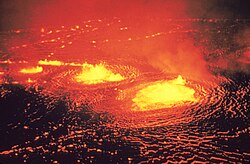This list of shield volcanoes includes active, dormant and extinct shield volcanoes. Shield volcanoes are one of the three types[ specify ] of volcanoes. They have a short cone shape, and have basaltic lava which means the lava has low viscosity (viscosity is a measure of the ability for a liquid to flow)
Contents
- Active
- Ecuador
- Other
- Dormant
- Canada
- United States
- Costa Rica
- Kenya
- Other 2
- Extinct
- Antarctica
- Other 3
- Other planets and satellites
- Mars & Venus
- Pyroclastic shields
- Bolivia
- Nicaragua
- Papua New Guinea
- Other 4
- See also
- References




